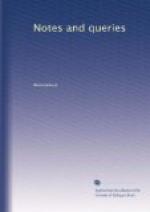As to the identity of the book, Dr. Anster quoted several passages from contemporary authors to test their account of the contents of the “album” with those of the book he was describing. In the Harleian Miscellany, vol. vi. p.323., it is stated in Sir John Reresby’s memoirs, that “out of his [Monmouth’s] pocket were taken books, in his own handwriting, containing charms or spells to open the doors of a prison, to obviate the danger of being wounded in battle, together with songs and prayers.” Barillon describes the book in what is nearly a translation of this—“Il y avoit des secrets de magie et d’enchantment, avec des chansons des recettes pour des maladies et des prieres.” Again, in a note by Lord Dartmouth to the modern editions of Burnet’s Own Times, we have the following statement:—
“My uncle Colonel William Legge, who went in the coach with him [Monmouth] to London as a guard, with orders to stab him if there were any disorders on the road, showed me several charms that were tied about him when he was taken, and his table-book, which was full of astrological figures that nobody could understand; but he told my uncle that they had been given to him some years before in Scotland, and he now found they were but foolish conceits.”
The actual contents of the manuscript volume show a great resemblance to these descriptions. The most curious passages which it contains are the duke’s memorandums of his journey on two visits to the Prince of Orange, in the year previous to his last rash adventure. His movements up to the 14th of March, 1684-85, are given. The entries do not seem to be of much




